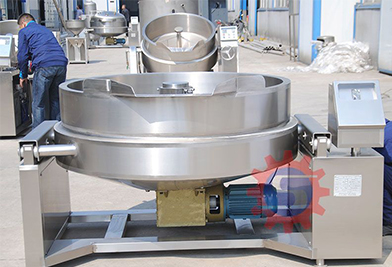How To Choose a Steam Jacketed Kettle
Kettles with steam jackets will play an important role as the healthcare business offers more nutritional and flavorful menu options. Soups, stews, soups, and sauces made from scratch maximize freshness and nutrients and are ideal for kettles. Many operations place these menu items in a stockpot over an open flame or hot burner, but without constant temperature monitoring and stirring, the products will scorch or boil. Delicate dairy and chocolate products have strong thermal properties, and turning the calories up or down can damage the whole batch.
Steam kettles stabilize food temperatures within a few degrees of the set temperature. The steam in the casing heats the contents of the kettle. By adjusting the pressure of the steam, the temperature can be raised or lowered to the desired setting. By transferring heat to all sides of the product, the kettle eliminates hot spots at the bottom of the soup pot and provides a more even distribution of heat. Usually, a fixed kettle has a full jacket over the entire length of the kettle, while a tilting kettle jacket covers two-thirds of the kettle, so the spout can be placed on top.

In addition, because heat is transferred to the kettle's inclusions in all directions, it reaches the desired temperature more quickly than a stockpot placed over a heat source. One manufacturer claims that kettles cook 30 percent faster than POTS.
One advantage of using a steam jacketed kettle is that you can make chicken soup all day at once. This not only eliminates the need for a batch by batch storage within a certain range, but also saves labor (since no one has to fill, stir and empty the POTS), reduces the possibility of injury while moving and carrying the full stock, and potentially frees up stoves for other uses. It also provides a consistent flavor that can be difficult to achieve when producing multiple batches in small quantities.
Since the introduction of steam kettles a few decades ago, temperature control has consisted mainly of temperature dials on a digital scale of 1 to 10 or various types, including extensive warming, slow stewing, and boiling. All of this adjusts the pressure of the steam in the jacket, thereby raising or lowering the cooking temperature. Gauges showing 50 psi may translate to approximately 298°F, while 25 psi implies 267°F.
Recently, some steam kettle manufacturers have begun to offer temperature-specific controls. The digital reading shows the temperature of the food in the kettle. Controls allow you to program the temperature and cooking time for each product. By default, your staff can consistently make these items every time.
While some above-ground kettles tilt to dump cooked products into hotel pans or containers, others have tangent discharge valves that allow you to drain products from the bottom of the container. An optional rack holds the pan in place and holds it level when the product is poured. Think about your current menu and what you might consider in the future; The chunky peppers and stews can be discharged through the 3-inch valve without a problem, but are blocked by the 2-inch valve.
Name: Gavin
Mobile: +86 181 3273 1506
Email: oath1@bdoath.com
WhatsApp: +86 181 3273 1506
Add.: No. 79, Swan Road, Gaokai District, Baoding, Hebei, China.